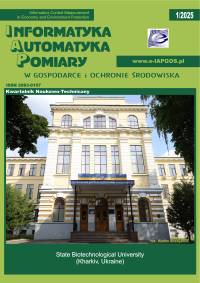METHOD OF OBTAINING THE SPECTRAL CHARACTERISTICS OF THE SCANNING PROBE MICROSCOPE
Mariia Kataieva
kataeva.mariia@gmail.comNational Aviation University, Kiev, Ukraine (Ukraine)
http://orcid.org/0000-0002-1586-1861
Vladimir Kvasnikov
National Aviation University, Kiev, Ukraine (Ukraine)
http://orcid.org/0000-0002-6525-9721
Abstract
The article discusses methods and algorithms for digital processing and filtering when carrying out nano-measurements using a scanning probe microscope. The paper discusses frequency methods for improving images, in particular, the use of the Fourier transforms with various filtering methods to improve the quality of the resulting image. Stable computational algorithms have been developed for transforming discrete signals based on the Fourier transform. Methods for the interpretation of the numerical results of the discrete Fourier transform in such packages as Matlab, MathCad, Matematica are presented. It is proposed to use a window transform, developed based on the Fourier transform, which makes it possible to single out the informative features of the signal and to reduce the influence of the destabilizing factors that arise when processing signals from a scanning gold microscope in real conditions.
Keywords:
nano-measurement, digital signal processing, scanning probe microscope, Fourier transformReferences
Addison P. S.: Secondary transform decoupling of shifted nonstationary signal modulation components: application to photoplethysmography. Int. J. Wavelets Multires. Inf. Proc. 2, 2004, 43–57.
DOI: https://doi.org/10.1142/S0219691304000329
Google Scholar
Falvo M. et al.: The nanomanipulator: A teleoperator for manipulating materials at the nanomerter scale. Proc. of Int. Symp. On Science and Technology of Atomically Engineered Materials, 1996, 579–586.
Google Scholar
Hyon C. K. et al.: Application of atomic-force-microscope direct patterning to selective positioning of InAs quantum dots on GaAs. Applied Physics Letters 77, 2000, 2607–2609.
DOI: https://doi.org/10.1063/1.1318393
Google Scholar
Ito K. J. et al.: Servomechanism for locking scanning tunneling microscope tip over surface nanostructures. Rev. of Sci. Inst. 71(2), 2000, 420–423.
DOI: https://doi.org/10.1063/1.1150217
Google Scholar
Iwasaki H., Yoshinobu T., Sudoh K.: Nanolithography on SiO2/Si with a scanning tunneling microscope. Nanotechnology 14, 2003, 55–62.
DOI: https://doi.org/10.1088/0957-4484/14/11/R01
Google Scholar
Majumdar A. et al.: Nanometer-scale lithography using the atomic force microscope. Applied Physics Letters 61, 2002, 2293–2295.
DOI: https://doi.org/10.1063/1.108268
Google Scholar
Mokaberi B., Requicha A. A. G.: Drift compensation for automatic nanomanipulation with scanning probe microscopes. IEEE Trans. on Automation Science and Engineering 3(3), 2006, 199–207.
DOI: https://doi.org/10.1109/TASE.2006.875534
Google Scholar
Mokaberi B., Requicha A. A. G.: Towards automatic nanomanipulation drift compensation in scanning probe microscopes. IEEE Int. Conf. on Robotics and Automation, New Orleans, LA, 2004.
DOI: https://doi.org/10.1109/ROBOT.2004.1307185
Google Scholar
Ohji H. et al.: Fabrication of a beam-mass structure using single-step electrochemical etching for micro structures (SEEMS). J. Micromech. Microeng. 10, 2000, 440–444.
DOI: https://doi.org/10.1088/0960-1317/10/3/320
Google Scholar
Roth S., Dellmann L., Racine G. A., de Rooij N. F.: High aspect ratio UV photolithography for electroplated structures. J. Micromech. Mecroeng. 9, 2009, 105–108.
DOI: https://doi.org/10.1088/0960-1317/9/2/001
Google Scholar
Sahoo D. R. et al.: Transient signal based sample detection in atomic force microscopy. Applied Physics Letters 83(26), 2003, 5521–5523.
DOI: https://doi.org/10.1063/1.1633963
Google Scholar
Said R. A.: Microfabrication by localized electrochemical deposition: experimental investigation and theoretical modeling. Nanotechnology 15, 2004, 867.
DOI: https://doi.org/10.1088/0957-4484/15/7/C01
Google Scholar
Salapaka S., De T.: A new sample-profile estimate for faster imaging in atomic force microscopy. Proceedings of the American Control Conference, Boston, MA, 2004.
DOI: https://doi.org/10.1115/IMECE2005-80511
Google Scholar
Salapaka М. V. et al.: Multimode noise analysis of cantilevers for scanning probe microscopy. Journal of Applied Physics 81(6), 1997, 2480–2487.
DOI: https://doi.org/10.1063/1.363955
Google Scholar
San Paulo A., Garcia R.: Tip-surface forces, amplitude and energy dissipation in amplitude–modulation (tapping mode) force microscopy. Physical Review B. 64, 2002, 041406 (1–4).
DOI: https://doi.org/10.1103/PhysRevB.64.193411
Google Scholar
Sebastian A. et al.: Robust control approach to atomic force microscopy. Proceedings of the IEEE Conference on Decision and Control, Hawai, 2003.
Google Scholar
Staub R. at al.: Drift elimination in the calibration of scanning probe microscopes. Rev. Sci. Inst. 66(3), 1995, 2513–2516.
DOI: https://doi.org/10.1063/1.1145650
Google Scholar
Yang Q., Jagannathan S.: Nanomanipulation using atomic force microscope with drift compensation. Proceedings of the 2006 American Control Conference, Minneapolis, Minnesota, USA, 2006.
Google Scholar
Yang S. et al.: Block phase correlation-based automatic drift compensation for atomic force microscopes. IEEE Int. Conf. on Nanotechnology, Nagoya, Japan, 2005.
Google Scholar
Yaseen A. S. at al.: Speech signal denoising with wavelet-transforms and the mean opinion score characterizing the filtering quality. Proc. SPIE. 9707, 2016, 970719.
DOI: https://doi.org/10.1117/12.2211384
Google Scholar
Authors
Mariia Kataievakataeva.mariia@gmail.com
National Aviation University, Kiev, Ukraine Ukraine
http://orcid.org/0000-0002-1586-1861
Authors
Vladimir KvasnikovNational Aviation University, Kiev, Ukraine Ukraine
http://orcid.org/0000-0002-6525-9721
Statistics
Abstract views: 267PDF downloads: 179
License

This work is licensed under a Creative Commons Attribution-ShareAlike 4.0 International License.








